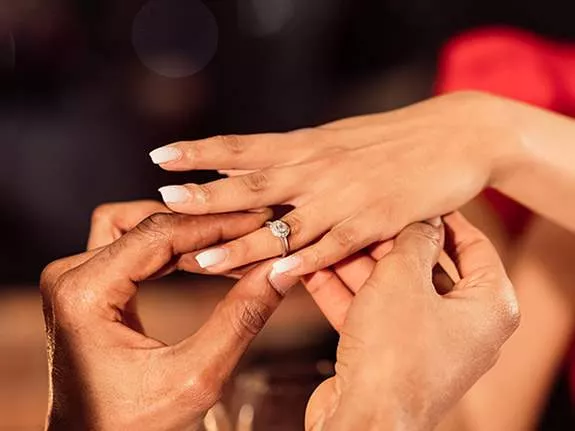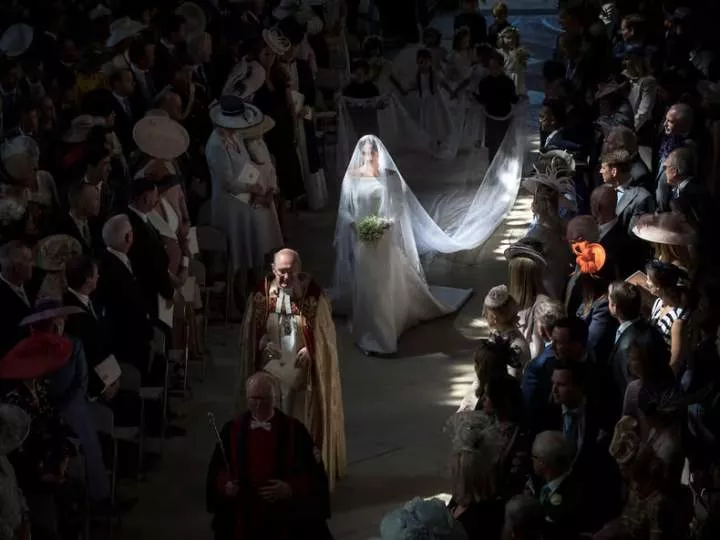
Though weddings are generally considered joyous and bright celebrations, many of their oldest traditions have dark and twisted origins.
Many wedding staples , like veils and bridesmaids, were originally tactics used to ward off evil spirits whose aim was to ruin the nuptials.
In medieval times, brides started to carry bouquets made of garlic and other herbs to disguise their own body odor.
When one thinks of weddings, one generally thinks of happiness: they're a day to celebrate family, friends , and, most importantly, the start of a new phase of life.
But historically, weddings were riddled with fear. Many traditions, like bridal veils and bridesmaids, had to do with warding off evil spirits. Engagement rings were originally worn to signify ownership, and the father "giving away" the bride used to be strictly business.
Here are 10 wedding traditions with surprisingly dark origins.
Romans used engagement rings to indicate ownership.

According to the American Gem Society, anthropologists believe that engagement rings date back to a Roman custom in which wives wore rings with keys attached, which indicated that their husbands owned them.
Engagement rings began to get a little less dark in 1477, when Archduke Maximilian of Austria commissioned an extravagant diamond ring for his new wife. The accessory grew in popularity in the Victorian era, and gradually the diamond ring trend trickled down from nobility to the masses.
Bridesmaids originally dressed alike to confuse vengeful spirits from harming the bride.

There is a theory that the tradition of bridesmaids dressing alike dates back to ancient Rome , the bride considered to be prime bait for vengeful spirits. So, all the women dressed alike to confuse the spirits from interrupting the bride and groom's nuptials.
Another theory, however, dates back to the Victorian era. Dr. Liz Gloyn, a lecturer in Classic and Royal Holloway at the University of London, told The Independent that the tradition stemmed from fear of competition .
"It is my belief that by regulating the bridesmaids formally into exactly the same garments, there was no room for any of them to try and outdo each other, let alone the bride, through the use of grander fabric, grander jewelry," Dr. Gloyn said.
Centuries ago, a groom had to "kidnap" the bride if her family disapproved of their union. The best man was put in place to defend the groom in case the family retaliated.

The best man originated as the groom's choice protector. Many centuries ago, it was common for a groom to "steal" a bride from her family if they didn't approve of the union and it was the best man's job to fight the family if they retaliated.
It was also common practice for the best man to stand next to the groom with a sword in tow on the day of the wedding. In fact, ancient groups like the Huns, Goths, and Visigoths would store weapons in the floor of the church in the event of a brawl.
Carrying the bride across the threshold was symbolic of the bride unwillingly leaving her family.

The practice of the groom carrying the bride across the threshold of their new home or bedroom dates back to ancient Rome. At the time, the bride had to prove that she didn't willingly leave her father's home , as doing so would have been improper.
Romans also believed evil spirits attempted to curse the couple one last time at the threshold, so the groom had to lift the bride's feet above the ground so as not to let the spirits enter her body.
The bouquet was originally used to mask the brides body odor, and it was often made with pungent herbs.

According to the Huffington Post, the tradition of the bride carrying a bouquet dates back to the 15th century . In medieval times, people didn't smell quite as good as they do now, so brides carried fragrant bouquets to mask their own body odor. The bouquets were often made with strong herbs, like garlic and dill.
Actually, the reason June weddings are so popular is because people used to take their annual baths in May.

To this day, people fantasize about having a June wedding but the fixation with that summer month dates back to the 15th century, and it also relates to smell. People used to take their annual baths in May , which made June the perfect time for a good-smelling public gathering.
Veils used to be red so that the bride looked like she was on fire, which would scare maleficent spirits away.

Back in Roman times, the bridal veil was actually a red sheet called a " flammeum ," which was designed to look like fire. The bride's entire body would be covered in it, in an attempt to scare off any evil spirits.
Over time, the red went away, but veils remained a tactic used to shield the bride from maleficent forces. They also were used to weigh the bride down, and prevent them from running away .
The father handing off the bride to her husband used to be more of a business transaction.

The tradition of the father of the bride walking his daughter down the aisle to "give her away" roughly dates back to the 1549 Book of Common Prayer and the Church of England . It was more of a business transaction than anything else, as the "giving away" referred to a transfer of property.
"In Britain, as in many places, women had long been considered essentially the property of men, first their fathers and then their husbands," according to Time. "The phrase 'give away' suggests a lot about the womans role in this exchange from one man to another."
Bachelor parties date back to ancient Sparta, and they have gotten more raucous as the years have gone on.

The tradition of a bachelor party, or "stag night," dates back to the 5th century BC in ancient Sparta. According to Time , "Spartan soldiers held a dinner in their friend's honor and made toasts on his behalf with, one assumes, a Spartan sense of decorum. Since then, the events have generally grown more raucous."
The more recent, wild iterations of bachelor parties gained popularity in the '80s thanks to a slew of sex comedies, according to Time.
Honeymoons originated as trips to go see the family that couldnt make it to the wedding.

Honeymoons used to be relatively anti-climactic, originating in 18th century Britain as trips the newlyweds would take after the wedding to visit relatives who weren't able to attend.
According to INSIDER, the word " honeymoon " became synonymous with a post-wedding vacation around 1791: "That usage first appears in a collection of German folk stories by Johann Karl August Musus, translated by Thomas Beddoes, according to the Oxford English dictionary.
"'The new-married couple spent their honey-moon in Augspurg, in mutual happiness and innocent enjoyments, like the first human pair in the garden of Eden,' the sentence goes."
















Comments